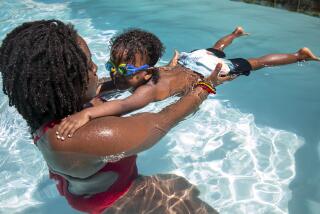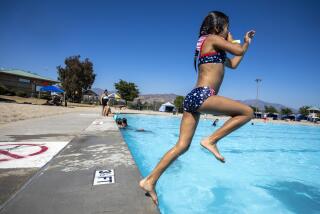CPR Snatches Children From the Brink : First aid: Study finds that youngsters who have apparently drowned but receive mouth-to-mouth resuscitation are much more likely to survive and escape brain damage.
- Share via
CHICAGO — Children who have apparently drowned but who receive immediate mouth-to-mouth resuscitation are much more likely to survive and escape brain damage than children who don’t receive such help, a study has found.
“We don’t want parents to wait for the arrival of the paramedics,” said Dr. Demetrios N. Kyriacou, who headed a study of 166 cases of drowning and near-drowning treated at Huntington Memorial Hospital in Pasadena, Calif.
No previous study, he said, has tried to measure the benefit of giving immediate resuscitation compared with not giving such help or waiting until trained emergency workers arrive.
The findings, reported in the August issue of Pediatrics, are consistent with current guidelines for using cardiopulmonary resuscitation on children, which call for giving one minute of CPR before calling 911.
Adults frequently need an electrical jump-start to get their hearts going, which requires a defibrillator and a trained person using it, so 911 should be called before starting CPR.
“A child typically has a very strong heart,” said Kyriacou, an assistant professor of medicine at the UCLA School of Medicine.
A child who is pulled blue and breathless from a pool or bathtub may have a pulse that is too faint to detect, he added, and a little help breathing may be all that’s needed.
Dr. John A. Paraskos, who headed the national panel of experts that revised CPR guidelines in 1992, said the new study is important.
“It emphasizes that learning CPR is a family responsibility, and everybody should learn it,” said Paraskos, director of diagnostic cardiology at the University of Massachusetts Medical Center in Worcester.
Courses in CPR usually take about four hours and are offered by local chapters of the American Red Cross.
Most of the rescuers in the study were parents, relatives or neighbors. The study’s findings suggest that many revived their children without formal training.
“Seventy-five percent of kids out of the 166 did get mouth-to-mouth or CPR,” which also involves chest compression, Kyriacou said. But, he said, only a small fraction of U.S. adults are certified in the technique.
That suggests people are learning the basics from television or other sources, or are getting enough directions from 911 telephone operators.
In the study, 148 children who were not breathing received some type of resuscitative effort, and of those, 22--or 14.9%--died or had brain damage. Of the 18 children who received no such effort, eight--or 44.4%--died or had brain damage.
After controlling statistically for differences in children’s ages, time of submersion and other variables, the researchers found that children who were revived and lived without brain damage were 4.75 times more likely to have received resuscitative efforts than other children.






